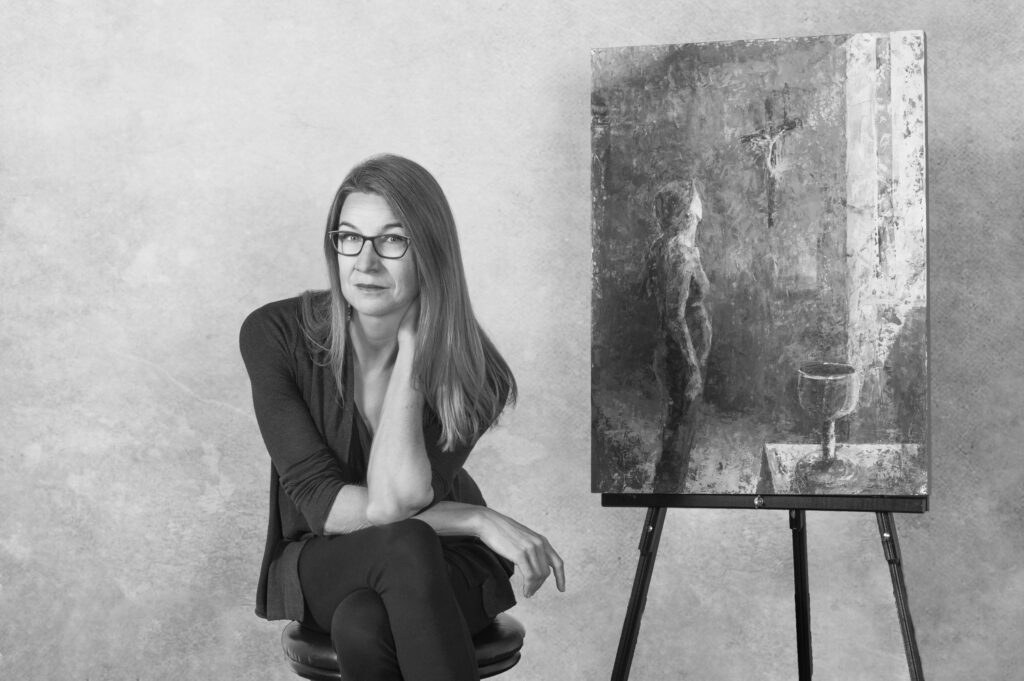Exploring and Studying in Italy
My most recent solo exhibition (Passages at the Schnormeier Gallery at Mt. Vernon Nazarene University) is a continuation of my series of paintings exploring Italian churches. It is years now that I return to this subject matter of Italian architecture and it seems natural to share the origins of my inspiration. I was reminded of it all on my most recent trip to Italy to study Romanesque churches for the Passages exhibition. I’ve illustrated this post with sketches from fall 2023, though I’m writing about my first encounters with sacred spaces in Italy, 25 years previous.
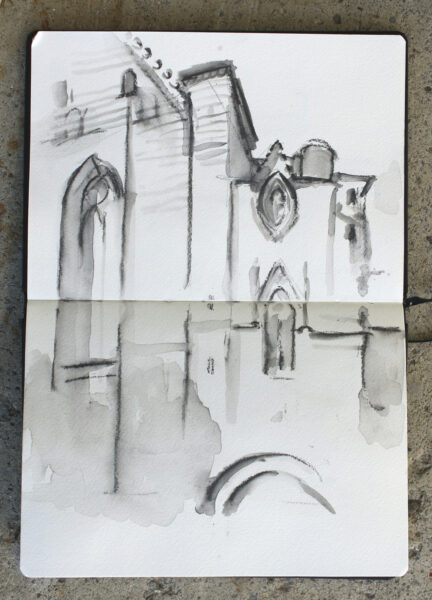
The Duomo of Orvieto, Rear View, Graphite on paper, ©Michelle Arnold Paine 2023
During that college study abroad year in Italy the seeds were planted for my journey to the Catholic Church and my life as an artist. I would not have the family or the life that I have were it not for those years in Italy and the time I spent exploring Italian churches. During my recent trip I re-visited many of those places that I first encountered my second semester in Italy as a college student, and the places and people who would eventually play a part in shaping these last 25 years.
Exploring Churches in Florence
As a junior in college I studied abroad one semester in Florence, Italy and one semester in Orvieto. I went to Italy because I wanted to study Art History. I was an English/Art double major with an art history concentration, pursuing a path which would prepare me for a graduate degree in Art History. My trip to Italy Junior year was the first hint that perhaps I would be happier making art than studying it.

“Medieval Archway: Orvieto, Italy” Graphite on Paper, 20″ x 14″ ©Michelle Arnold Paine
That first semester in Italy as a college student, I lived about a mile and a half from the heart of Florence. A 70-year-old Italian woman who supplemented her income by housing foreign students hosted us. I would take the bus into the center of town in the morning for my classes, but had lots of free time during the day to explore. Being a tourist all day every day can be quite exhausting. Some of my student cohort seemed to have inexhaustible energy and wallets for shopping, but that was not the case for me!
Italian Churches: A Place to Rest
I soon discovered that most churches in Italian cities were always unlocked and open. I would find myself exploring these Italian churches, and often staying to sit, look, and listen. The church I had grown up attending was in the Chicago suburbs barren modernist brick. In contrast, these empty ancient spaces were an invitation to encounter beauty.
Florence is filled with the most famous artworks in the world. Behind any door you might stumble upon an image from one of your art history books. In addition to those “most famous” artworks there are thousands more less famous ones.
Inside these churches there would usually be a couple tourists, perhaps someone in prayer, but there were always pews to sit on. If I had been walking around a great deal and felt tired, I found I could always rest in a church. If it was raining, or hot, I could take refuge from the noise, the rain, or the heat (though not the cold!) inside a church building. It was quiet, no one would ask me to leave, it cost no money, and it was beautiful. There were some times when I sat in the quiet churches for company, just me and Jesus.
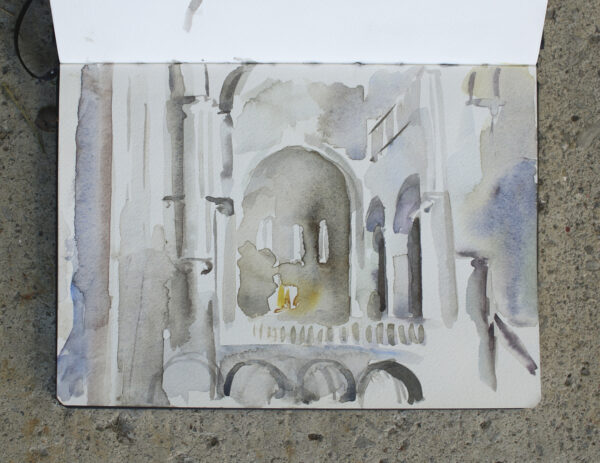
“Santa Maria della Pieve, Arezzo” watercolor on paper, Italy Sketchbook, ©Michelle Arnold Paine 2023
Italian Churches: A Place to Learn
I used the churches that semester in Florence as a refuge, but I also went to worship. I wanted to experience church as a part of Italian culture, so I attended Mass in Italian on Sunday mornings. There, the rhythm of the liturgy aided in my language learning. I soon discovered that the Catholic Mass was nearly identical to the Episcopalian liturgy that I had been attending at college. In this way I was able to piece together where we were in the service and slowly begin to grow my Italian vocabulary. There are more reasons than you might think to attend church each Sunday!
On Sunday mornings, in the great basilica of Santa Croce in Florence, there were only 50-100 older people at the Mass. The church had been built to hold thousands for the preaching of the great Franciscan preachers. I could feel the presence of Tradition, of many who had gone before me, and were still alongside me. At the same time, I could feel that these places were in some sense left behind by contemporary Italians and thought to be irrelevant.
These buildings held beautiful artistic and spiritual riches, but were no longer being used in the way they had been intended. People came to marvel at the architecture and the paintings and the history but they did not come to worship God. In my paintings I attempt to convey this sense that the structure remains but holds only a shadow of the life and vitality it was intended to contain.
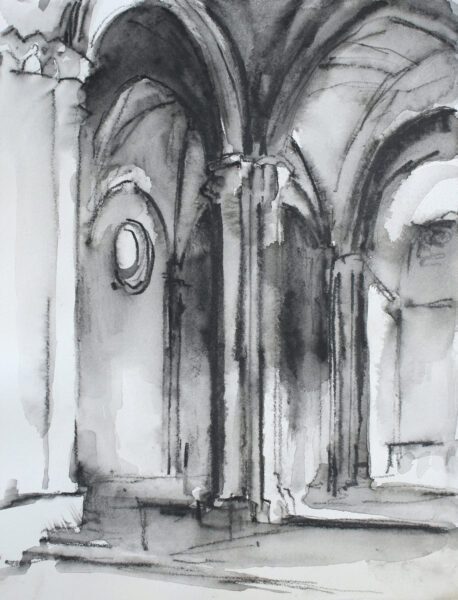
“Sant’Andrea, Orvieto” Graphite on Paper, 10″ x 8″ ©Michelle Arnold Paine 2023
Churches in Orvieto
The following spring I went to Orvieto to participate in Gordon College’s first ever semester-long study abroad program in Italy. The semester I had spent in Florence gave me a head start in learning Italian. Exploring Italian churches in the small town of Orvieto included developing relationships with the people who worshipped in those places.
The religious hospitality house hosted the Gordon program in a convent which had previously been a boarding school. Parts of its structure dated back to the 1100 and 1200s. In the “Vecchia Cucina” – the old kitchen, there were 1960s commercial kitchen appliances from its days as a boarding school – and a 15th century fresco of the Annunciation! The “old kitchen” had been the chapel of the convent hundreds of years ago.
Church: A Place of Encounter
A new friend brought me to Vespers at a different convent of poor Clares. The cloistered sisters had taken a vow of poverty and prayed five times a day in a ridiculously opulent gilded Baroque church. There were contradictions everywhere.
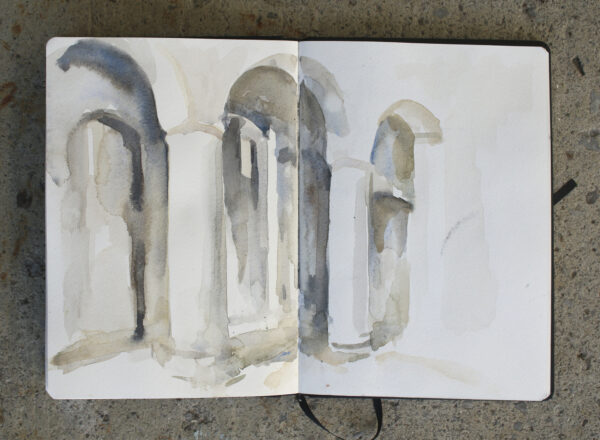
“San Giovenale, Orvieto” watercolor on paper. From the 2023 Italy sketchbook of Michelle Arnold Paine
There were no Protestant churches in town, so we students attended the parish of San Giovenale in Orvieto. At that time the church building was just a few years away from its 1000th birthday. The young man who played guitar for the choir heard us singing and asked us to join the choir. Pastor Don Enrico knew we were not Catholic, but he welcomed us. He was thrilled that there were young people who desired to come to church and lift their voices in praise. Consequently my voice began to join the voice of thousands of others in the millennium-long history of that church building. People had been worshipping there for longer than Europeans had been in the New World!
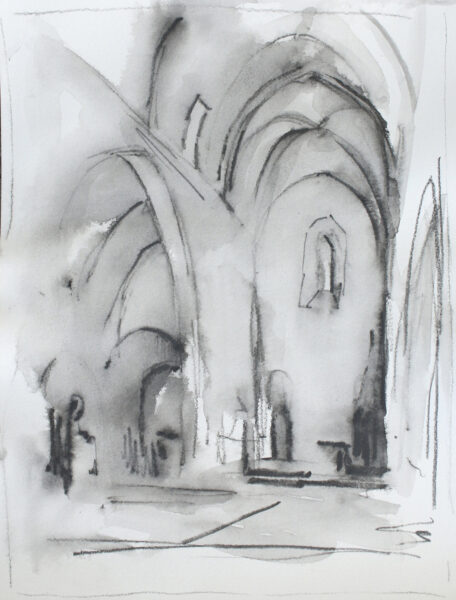
“San Giovenale, Orvieto” Water soluble graphite on paper, From the 2023 Italy sketchbook of Michelle Arnold Paine
And so my life, my relationships, my community in Orvieto became interwoven in these ancient spaces. My experience of community and relationship differed so drastically between the US and Italy. In a way, exploring Italian churches through painting and drawing was part of how I sought to understand this contrast. Resting, learning, and sketching inside these ancient sacred spaces became the impetus for a body of work devoted to sacred architecture.

